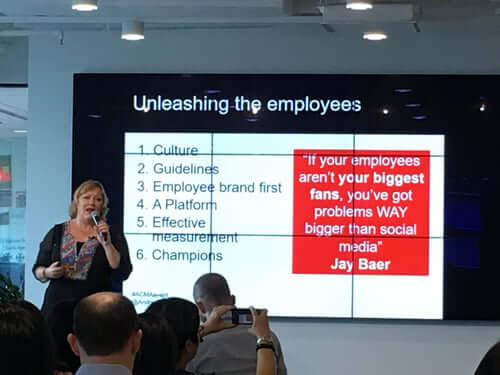When employees struggle to find the information they need to meet their targets and develop their skills, it’s their motivation and happiness as well as the company’s performance that suffer.
Think about it: how can your teams excel in their work and how can your employees be motivated if they can’t find the right information from the right place? Knowledge sharing leads to cross-departmental communication, creativity, team collaboration, social interactions and at the bottom line, employee engagement. But your employees can also share meaningful content with their networks and thus become trustworthy ambassadors.
Andrea Edwards, the founder of The Digital Conversationalist, shares her insights on knowledge sharing in the workplace and Employee Advocacy:
Hi Andrea, can you tell us a bit more about your background, what’s your story?
Australian-born, I left home in 1995, to travel and live around the world, and have enjoyed time in London, Boston, NYC, a quick visit to Sydney, then 15 years in Singapore before moving to Phuket, Thailand six months ago.
My early career was focused on public relations, predominantly in the tech space, then I moved into marketing services, which evolved into content marketing.
I was too early for content marketing when I launched my first business, so took a role at Microsoft, then content agency John Brown Novus, before finally, two years ago, decided the time was right to launch The Digital Conversationalist – where I focus on helping brands unleash their employees to become social leaders and content creators. I love what I do today.

According to you, why building a knowledge sharing culture should be a top priority for any organization?
The insular, spreadsheet watching, quarter-by-quarter measurements mindset of most companies today KILLS a knowledge sharing culture.
I have worked with so many companies and it feels like everyone is looking at their naval, oblivious to the rapidly advancing world happening outside this internal view. It’s why, I believe, big companies miss so many key trends and are often the last to innovate, which is why the life expectancy of business has reduced so significantly. When everyone is too busy inside, everything continues to change outside.
Being a social leader forces you to exist outside the company view. When you share the external view – even if you don’t agree with it – it changes the way everyone thinks, and it absolutely has to be a core part of the company culture today. Staying on the pulse of your industry is about looking up and looking out to see what’s going on!
Everyone talks about customer experience (CX), but if you’re still an inwardly looking business, how can you deliver to the customer, when the customer is just a name or a category? How can you possibly understand the customer?
A knowledge sharing culture is the only way to build a business of the future, and employees actively and intelligently engaging on social media can only be more externally focused, because they’re actively participating and learning out there.
I’ve always been the person reading excessive amounts of information, because I am always trying to understand the big picture. If I can’t see the big picture, how can I put everything into context for my audience, right? That deep desire in me to understand also inspires me to share what I’m finding because I think that if I’m trying to get it, surely everyone else is?
Today, a knowledge sharing culture is absolutely paramount, as the speed of change is like nothing we’ve ever seen before. We are standing witness to the greatest seismic shifts in human history, so understanding that shift and where we fit in the mix of it, should be a focus for everyone.
It’s a truly fascinating world out there, bring it into the core of your business culture and watch the sparks fly!
Do you think that companies should help the employees in developing their thought leadership and personal brand on social media?
I’m not sure companies can help employees do it, probably the better way to think about it is companies must facilitate the empowerment of their employees to become social leaders and make sure there is a culture of trust in employees to embrace it.
One of the constant challenges I hear from employees is, they are being asked – sometimes quite forcefully – to get on social media and share company information.
The problem is the employees don’t like this. They tell me they hate this expectation, that it doesn’t have integrity, it feels insincere and they would rather do nothing than not be true to themselves. I wrote this blog – where leadership teams are going wrong with Employee Advocacy, and what you can do about it to address this common feedback.
When companies get this wrong, it turns employees off even starting. However, if businesses get it right – focusing on the employees first, brands second – the next step is understanding the challenges employees are consistently facing and helping them overcome those challenges.
I always recommend the starting point is to help employees work out what their focus is (what they want to be known for – their eminence), and this focus must be tied to a personal passion (even if it’s non-business related) because passion will keep the employees engaged. Help them find their focus first, which can cover so many areas – the problem you solve for customers, leadership, inspiration, equality, all the way to being a food blogger.
Of course, many ask me how can a food blogger working for a serious business impact company growth? People are passionate about a lot of things — spirituality, family, food, mindfulness, health and wellness, and so many other “non-business” topics — but these topics also open doors to customers. Customers want to know these people.
The millennials want to work for a company that hires people who are passionate about things beyond work. It’s a great insight into company culture, and with 50 percent of the workforce expected to be millennials by 2020, this is how you attract that generation, because their number one priority is company culture.
Employee Advocacy is powerful across many layers of the business. Its benefits are far wider than many give it credit for. Employee Advocacy doesn’t just generate sales (which it does) it achieves a lot more, including increased employee engagement, if you start with the right mindset.
After employees find their voice, it’s then about helping them find the self-confidence to embrace this opportunity, and no matter who I’ve worked with, self-confidence is the biggest issue stopping people – who cares what I have to say? Everyone I’ve ever met has a story, believing that story is worth sharing is the biggest hurdle.
If they’re focused and keen to embrace the opportunity, next it’s helping them define some simple steps to get started (which is usually curation of other content aligned to their focus) and helping them see that this does not have to be time-consuming.
There is so much noise today, it’s better to do less and do it brilliantly, than commit hours and hours to it, when it’s very rare to find an employee who wants to go that hard. We all have jobs today. If employees see Employee Advocacy as a burden, they won’t do it.
And finally, as a favor to the business, ask them to share one piece of company content a week – or less – and then the responsibility is then on the company to create content employees actually want to share! If it’s a sales pitch, employees with integrity won’t share it.
According to you, how does Employee Advocacy support this strategy?
When you work for a company, you benefit by the association with the company brand. As an example, when I worked for Microsoft, my social leadership position was more highly valued, because I had a powerful brand behind my name. So to honor the brand you work for, because hopefully you love the company, helping it succeed by being an advocate for it should be a no-brainer, but ONLY if the information is good enough.
Making it as easy as possible for employees to get access to great company information is imperative, which is why companies like Smarp are so important, but many of the other Employee Advocacy tools are making it too easy. As an example, it’s common to see thousands of employees sharing exactly the same information with the same social content and hashtags. Now if I know 100 people working for the same company, I will see 100 duplicate posts and I can’t stand this. The intelligent people I work with can’t stand it either.
Even if it’s company information, this is your brand, and anything you share should be aligned to what you stand for, be meaningful to you personally, and you must want to share it.
There will always be employees who do as they’re told, but the ones who think carefully about how they are positioned on social media are the ones you want as advocates. It is the personal credibility of each and every employee that will help brands grow today.
It’s not about splashing news and information around in vast numbers. It’s about helping employees understand their individual influence, and collectively, they are beyond powerful in helping companies grow.

What are the dos and don’ts for implementing a successful Employee Advocacy program?
Don’t force it, because you can’t. Start with the employees first. Help them define their social leadership position, coach them, guide them, empower them, and then help them get started with simple tips and tricks. Show them where they can get easy access to company information (the Employee Advocacy platform, website, LinkedIn company page, blogs, etc.) and then celebrate and honor the employees doing an awesome job.
However, please don’t get set up so you reward employees for spamming all of their social networks. I have seen this time and time again, and have said to CMOs: so you’re rewarding employees for being morons?
Sound harsh? We all have those friends on platforms, like Facebook, sharing boring company information. It is rare that company information is relevant on the more personal social media platforms, so other than awesome CSR content – building wells in Sri Lanka, saving lives in Africa – most company information has no place on those platforms. You’d hope your employees are switched on enough to understand this, but not all are. The best thing is not to reward this kind of behavior in the first place and educate them about what’s relevant for what audience.
The other critical piece is making sure you’re providing great content that is worthy of your employees to share. Just that will make a difference. That’s why awesome content marketing, as well as employee content, must be a critical focus for business right now.
Measurement is difficult because there is no one measurement solution to get the full spectrum of impact, especially as employees favor different social platforms – something that should be encouraged.
Employees must participate where they’re comfortable, although, in the B2B space, LinkedIn should be a requirement for all. If you’re encouraging employees to blog and there’s too much red tape getting a content platform launched, LinkedIn is an awesome place for employees to publish their own content. Outside of global headquarters, it’s a short-cut to employee content creation, and I encourage brands and employees to utilize it, especially if there’s too much control at HQ and not enough value placed on employees in the regions. This is a common issue!
Getting back to social platforms, some people love Instagram – so build a professional presence there. Twitter is a passion for many – awesome, go for it. In Asia, there is a whole other world of social platforms (WeChat, Line, KaoKaoTalk) and the people in those markets know which platform is best to reach their customer, their audience.
I had a recent conversation with a B2B sales person in Thailand. She’s doing awesome work but wasn’t achieving great success on LinkedIn. She decided to move it to Facebook and leads started coming in. Facebook in Indonesia, Thailand and the Philippines is used in a completely different way to the rest of the world, so understanding the nuances in each country is important. There can be no one size fits all.
But measurement is challenging, so the dialogue must be open. Feedback mechanisms should be put in place – especially if you want to start measuring wins. Internal champions can also become motivators for other employees, and if you have a great collaboration tool, sharing employee content, wins, successes, honoring the champions, etc. is vital.
What content should employees be encouraged to share with their colleagues and on social media?
Once you decide on your focus area, at least 80 percent of the content you share (your own or others) should be aligned to that focus area.
I suggest sharing three types for content aligned with your topic:
- Thought leadership content (HBR, NYT, consulting groups, etc.)
- Industry knowledge (where you go to learn your craft)
- Inspirational pieces (TED Talks, etc.)
You share a selection of content across these three areas regularly – every day, once a week, whatever you want to do – and over time, you build up your credibility in the area you want to be known for.
As an example, I share information on content marketing, Employee Advocacy, and social leadership as my core topics. If you are interested in these areas, you don’t need to follow anyone but me, because I am finding and sharing the best information in the world for my area, consistently building my brand and value as an expert in this area by doing so.
The other 20 percent can include company information, or causes you care about – so I’ll share on equality and parity, the environment, and sassy information that inspires me.
This is the “aha” moment in my training for many. Everyone is already reading or watching information that inspires them or helps them learn, I’m just showing them how to take that next step to share it with the world.
About Andrea Edwards: Andrea is a globally awarded B2B communications professional with more than 20 years of experience. She is a social leadership, Employee Advocacy and personal branding trainer for businesses and professionals. She is the Chairman of the Asia Content Marketing Association (ACMA) and the founder of the blog AndreaTEdwards. You can follow her latest activities on Facebook, Google+, Twitter and LinkedIn!











